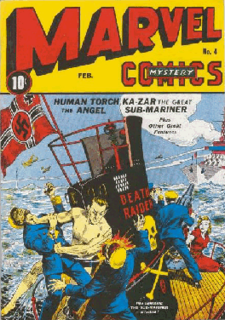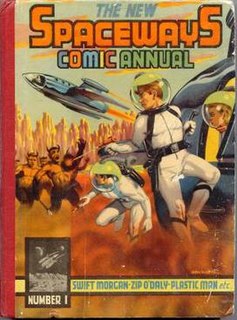History
Boardman pioneered British reprinting of American comics. During the week of October 16, 1937, the first issue of a Boardman tabloid comic in the traditional British format, Okay Comics Weekly, arrived at newsagent's all over England. The content was mostly American newspaper strips and the first issue sported a cover strip by Will Eisner. Okay lasted only until February 26, 1938, or a total of twenty issues. At about this same time, other British publishers experimented with reprinting American comics and imports of the real thing began to land on British shores. It rapidly became apparent that a significant British market for American comic books existed.

William Erwin Eisner was an American cartoonist, writer, and entrepreneur. He was one of the earliest cartoonists to work in the American comic book industry, and his series The Spirit (1940–1952) was noted for its experiments in content and form. In 1978, he popularized the term "graphic novel" with the publication of his book A Contract with God. He was an early contributor to formal comics studies with his book Comics and Sequential Art (1985). The Eisner Award was named in his honor, and is given to recognize achievements each year in the comics medium; he was one of the three inaugural inductees to the Will Eisner Comic Book Hall of Fame.
However, the British declaration of war on Germany on September 3, 1939, immediately halted the official importation of American comics into the United Kingdom although masses of American comics intended for G.I.s began arriving in 1942. Already with a taste for American comics, Thomas Volney Boardman, Sr., made an arrangement with Everett M. "Busy" Arnold of Quality Comics to produce British editions of two titles, Feature Comics (#29-33) and Smash Comics (#7-11), all appearing in 1940-1941. Because Boardman needed low-priced titles to please his primary outlet, Woolworths Group's Department Stores, the British editions reprinted only about half the content of the American originals. To use the rest of the pages, Boardman created two additional corresponding titles in the American style, Super Funnies (#29-33) and Mystery Comics (#7-11).

The United Kingdom, officially the United Kingdom of Great Britain and Northern Ireland but more commonly known as the UK or Britain, is a sovereign country lying off the north-western coast of the European mainland. The United Kingdom includes the island of Great Britain, the north-eastern part of the island of Ireland and many smaller islands. Northern Ireland is the only part of the United Kingdom that shares a land border with another sovereign state—the Republic of Ireland. Apart from this land border, the United Kingdom is surrounded by the Atlantic Ocean, with the North Sea to the east, the English Channel to the south and the Celtic Sea to the south-west, giving it the 12th-longest coastline in the world. The Irish Sea lies between Great Britain and Ireland. With an area of 242,500 square kilometres (93,600 sq mi), the United Kingdom is the 78th-largest sovereign state in the world. It is also the 22nd-most populous country, with an estimated 66.0 million inhabitants in 2017.

Everett M. Arnold, also known as Busy Arnold, was an American publisher and an early comic-book entrepreneur whose company Quality Comics published during the 1930s and 1940s period fans and historians call the Golden Age of Comic Books. He was also instrumental in the publishing arrangement that led to Will Eisner's newspaper Sunday-supplement comics series The Spirit.

Quality Comics was an American comic book publishing company which operated from 1937 to 1956 and was a creative, influential force in what historians and fans call the Golden Age of Comic Books.
After World War II, Boardman continued comic book production with a series of monthly comics produced by rotogravure and priced at a modest 3 pence. In the late-1940s, they introduced a number of children's annuals under their Popular Press line, intended primarily for the Christmas market and sold almost exclusively through the Woolworth's department store chain. These annuals contained a mixture of text and comic strip stories. Some were original British creations while others were reprinted from Quality Comics. In the late 1950s, increased competition with now legal American comic book imports caused Boardman to drop their comics annual line. The last, Buffalo Bill True West Annual saw print in 1961.

World War II, also known as the Second World War, was a global war that lasted from 1939 to 1945. The vast majority of the world's countries—including all the great powers—eventually formed two opposing military alliances: the Allies and the Axis. A state of total war emerged, directly involving more than 100 million people from over 30 countries. The major participants threw their entire economic, industrial, and scientific capabilities behind the war effort, blurring the distinction between civilian and military resources. World War II was the deadliest conflict in human history, marked by 50 to 85 million fatalities, most of whom were civilians in the Soviet Union and China. It included massacres, the genocide of the Holocaust, strategic bombing, premeditated death from starvation and disease, and the only use of nuclear weapons in war.
The firm ceased operations entirely in 1967, although the Bloodhound Mystery line continued for several years from other publishers. The Bloodhound Mystery authors included Drew (Droo) Launay, who wrote the Detective Adam Flute novels:
- She Modelled Her Coffin
- The New Shining White Murder
- A Corpse in Camera
- Death and Still Life
- The Two Way Mirror
- The Scream
An American comic book is a thin periodical, typically 32 pages, containing comics content. While the form originated in 1933, American comic books first gained popularity after the 1938 publication of Action Comics, which included the debut of the superhero Superman. This was followed by a superhero boom that lasted until the end of World War II. After the war, while superheroes were marginalized, the comic book industry rapidly expanded, and genres such as horror, crime, science fiction, and romance became popular. The 1950s saw a gradual decline, due to a shift away from print media in the wake of television and the impact of the Comics Code Authority. The late 1950s and the 1960s saw a superhero revival, and superheroes remain the dominant character archetype in the 21st century.
See also: 1920s in comics, other events of the 1930s, 1940s in comics and the list of years in comics
Notable events of 1939 in comics. See also List of years in comics.

Marvel Mystery Comics is an American comic book series published during the 1930s–1940s period known to fans and historians as the Golden Age of Comic Books. It was the first publication of Marvel Comics' predecessor, Timely Comics, a division of Timely Publications.
Carl Burgos was an American comic book and advertising artist best known for creating the original Human Torch in Marvel Comics #1, during the period historians and fans call the Golden Age of comic books.

The Vision (Aarkus) is a fictional superhero appearing in American comic books published by Marvel Comics. Created by the writer Joe Simon and artist Jack Kirby, the character first appeared during the Golden Age of comic books in Marvel Mystery Comics #13, published by Marvel predecessor Timely Comics.

Jungle Jim is the fictional hero of a series of jungle adventures in various media. The series began in 1934 as an American newspaper comic strip chronicling the adventures of Asia-based hunter Jim Bradley, who was nicknamed Jungle Jim. The character also trekked through radio, film, comic book and television adaptations. Notable was a series of films and television episodes in which Johnny Weissmuller portrayed the safari-suit wearing character, after hanging up his Tarzan loincloth.

Fiction House was an American publisher of pulp magazines and comic books that existed from the 1920s to the 1950s. It was founded by John B. "Jack" Kelly and John W. Glenister. By the late 1930s, the publisher was Thurman T. Scott. Its comics division was best known for its pinup-style good girl art, as epitomized by the company's most popular character, Sheena, Queen of the Jungle.
Denis McLoughlin was a well-known British illustrator.
Bloodhound Mystery is a novel series published by the London firm of T.V. Boardman Ltd. between 1948 and 1967. There were two sub-series, American Bloodhound Mysteries and British Bloodhound Mysteries. Both series saw the original hardcover editions of many important works of detective/crime fiction. British artist Denis McLoughlin served as art director for Boardman Books and provided many of the dust jacket illustrations.
Colin McLoughlin is a British freelance writer. With his brother Denis McLoughlin, Colin created the comic book charactersSwift Morgan, Roy Carson, Buffalo Bill, Sam English, and other comic book characters in the 1940s-1950s for the London publishing house TV. Boardman, Ltd..
L. Miller & Son, Ltd. was a British publisher of magazines, comic books, and pulp fiction intended primarily to take advantage of the British ban on importing printed matter. Between 1943 and 1966, the firm published British editions of many American comic books, primarily those of Fawcett Comics. They are best known for the 1954 creation of Marvelman – a blatant imitation of the Golden Age Captain Marvel – after America's Fawcett Publications capitulated to National Periodicals. L. Miller & Son also published a large line of Western comics, many reprints but also some original titles.

Motion Picture Funnies Weekly is a 36-page American comic book created in 1939, and designed to be a promotional giveaway in movie theaters. While the idea proved unsuccessful, and only a handful of sample copies of issue #1 were printed, the periodical is historically important for introducing the enduring Marvel Comics character Namor the Sub-Mariner, created by writer-artist Bill Everett.
The Eastern Color Printing Company was a company that published comic books, beginning in 1933. At first it was only newspaper comic strip reprints, but later on original material was published. Eastern Color Printing was incorporated in 1928, and soon became successful by printing color newspaper sections for several New England and New York papers. Eastern is most notable for its production of Funnies on Parade and Famous Funnies, two publications that gave birth to the American comic book industry.
Harry Frank Sahle was an American comic book artist who drew for such publishers as Archie Comics—helping create the defined look of Archie Comics' breakout character, Archie Andrews—Quality Comics and the Marvel Comics precursor company Timely Comics during the 1930s-1940s period historians and fans call the Golden Age of Comic Books.

Horror comics are comic books, graphic novels, black-and-white comics magazines, and manga focusing on horror fiction. In the US market, horror comic books reached a peak in the late 1940s through the mid-1950s, when concern over content and the imposition of the self-censorship Comics Code Authority contributed to the demise of many titles and the toning down of others. Black-and-white horror-comics magazines, which did not fall under the Code, flourished from the mid-1960s through the early 1980s from a variety of publishers. Mainstream American color comic books experienced a horror resurgence in the 1970s, following a loosening of the Code. While the genre has had greater and lesser periods of popularity, it occupies a firm niche in comics as of the 2010s.














